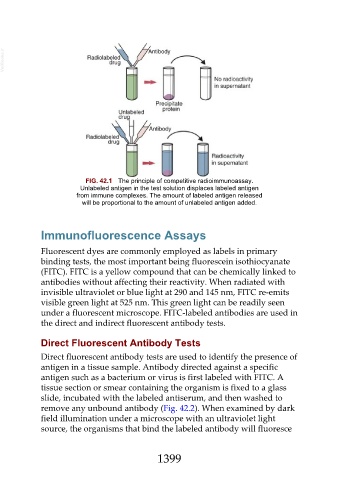Page 1399 - Veterinary Immunology, 10th Edition
P. 1399
VetBooks.ir
FIG. 42.1 The principle of competitive radioimmunoassay.
Unlabeled antigen in the test solution displaces labeled antigen
from immune complexes. The amount of labeled antigen released
will be proportional to the amount of unlabeled antigen added.
Immunofluorescence Assays
Fluorescent dyes are commonly employed as labels in primary
binding tests, the most important being fluorescein isothiocyanate
(FITC). FITC is a yellow compound that can be chemically linked to
antibodies without affecting their reactivity. When radiated with
invisible ultraviolet or blue light at 290 and 145 nm, FITC re-emits
visible green light at 525 nm. This green light can be readily seen
under a fluorescent microscope. FITC-labeled antibodies are used in
the direct and indirect fluorescent antibody tests.
Direct Fluorescent Antibody Tests
Direct fluorescent antibody tests are used to identify the presence of
antigen in a tissue sample. Antibody directed against a specific
antigen such as a bacterium or virus is first labeled with FITC. A
tissue section or smear containing the organism is fixed to a glass
slide, incubated with the labeled antiserum, and then washed to
remove any unbound antibody (Fig. 42.2). When examined by dark
field illumination under a microscope with an ultraviolet light
source, the organisms that bind the labeled antibody will fluoresce
1399

